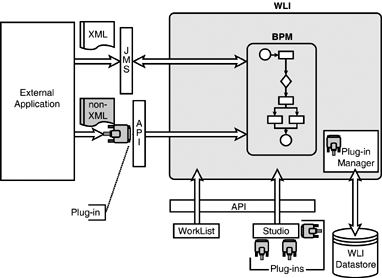BPM Plug-in Framework
| BPM supports plug-in development for extending its functionality. A plug-in is used to extend design and/or runtime behavior. It modifies the behavior of various workflow components , including start, event, and done nodes; task actions; functions; message types; and so on. One example is extending the behavior of the start node being triggered by a non-XML message. In Figure 34.13, an external application interacts with BPM by both an XML and a non-XML event. The standard way of triggering BPM is by placing an XML message on a JMS queue. A non-XML event can be made to trigger a BPM workflow by using a plug-in. BPM clients such as Studio can also use plug-ins to enhance their functionality. The plug-in manager supports the configuration, design, and runtime management of plug-ins. The plug-in manager oversees the loaded plug-ins and their interactions with the WebLogic Integration process engine and BPM clients . Figure 34.13. BPM plug-in architecture. The plug-in manager's functionality is exposed via the plug-in API, which consists of the following packages:
|
EAN: 2147483647
Pages: 360
